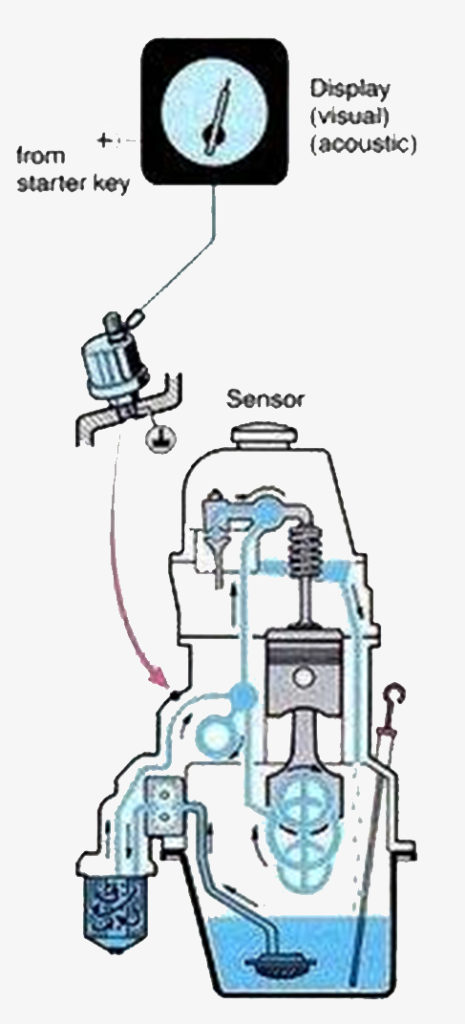Monitoring The Engine Oil Pressure
The circulation of the lubricating oil around the engine has quite rightly been likened to the human blood circulation system. The oil is pumped from the sump through the filter and into the bore holes leading to the main bearings on the crankshaft. After leaving these main bearings, the oil flow is divided. Part of it flows across the crankshaft to the connecting rod bearings and the piston bolts before being recycled, while another part lubricates the bearing faces of the cylinder through a centrifugal effect.
 The remainder of the oil passes through boreholes to the engine cylinder head, where it provides lubrication for the camshaft, the rocker shaft and valve slide mechanisms, before returning to the sump. The main function of the engine oil is to lubricate. Ideally, the film of oil would be so homogenous that there would be no contact between the metal surfaces to the bearings. Unfortunately, this ideal situation is interrupted whenever it occurs by the engine being switched off. The film disperses, leaving no protective film between the journal pins and the bearing shells. When the engine is started from cold, considerable wear can be caused. At other points, for example at the contact surfaces of the cylinders, the lubricating film is little more than partial, with the result that wear can also be caused here. This brings us to the second main function of the lubricating oil, namely the removal of all abrasion particles and impurities from the bearings. These particles are usually minute metal chippings from the bearings themselves or the contact surfaces, while the impurities are normally combustion residues that have found their way into the crankcase as result of a lack of tightness of the piston rings. The particles and the impurities are removed at the oil filter, so that the oil flowing around the lubricating points is always clean. This also means that the oil filter will have to be replaced at regular intervals, as otherwise the excess pressure in the filter will cause an overflow valve to open and the unfiltered oil will be returned through a bypass valve to the bearings. Furthermore, this cannot be detected at the oil pressure gauge.
The remainder of the oil passes through boreholes to the engine cylinder head, where it provides lubrication for the camshaft, the rocker shaft and valve slide mechanisms, before returning to the sump. The main function of the engine oil is to lubricate. Ideally, the film of oil would be so homogenous that there would be no contact between the metal surfaces to the bearings. Unfortunately, this ideal situation is interrupted whenever it occurs by the engine being switched off. The film disperses, leaving no protective film between the journal pins and the bearing shells. When the engine is started from cold, considerable wear can be caused. At other points, for example at the contact surfaces of the cylinders, the lubricating film is little more than partial, with the result that wear can also be caused here. This brings us to the second main function of the lubricating oil, namely the removal of all abrasion particles and impurities from the bearings. These particles are usually minute metal chippings from the bearings themselves or the contact surfaces, while the impurities are normally combustion residues that have found their way into the crankcase as result of a lack of tightness of the piston rings. The particles and the impurities are removed at the oil filter, so that the oil flowing around the lubricating points is always clean. This also means that the oil filter will have to be replaced at regular intervals, as otherwise the excess pressure in the filter will cause an overflow valve to open and the unfiltered oil will be returned through a bypass valve to the bearings. Furthermore, this cannot be detected at the oil pressure gauge.
In recent years, the lubricating oil has taken on an increasingly important third function – that of cooling. In modern engines, as much as 15% of the heat is generated can be dissipated by the lubricating oil.
It is clear that such an important circuit requires an efficient monitoring system. In some cases it is sufficient for the oil pressure to be monitored by means of a low oil pressure switch. However, it is generally advised that a pressure gauge is fitted, or alternatively, and an even better solution is to fit a combination of a warning contact and gauge. As the pressure builds up the problem is revealed by the gauge, which will give a good indication of the general state of the engine. The oil pressure is usually measured through a drilled hole in the engine block and through which the oil is pumped from the bearings. If there is any bearing damage in the vicinity of the crankshaft, the resistance is reduced and more oil flows across the crankshaft. This has the effect of lowering the pressure at the measuring point. The oil pressure will also fall if too much oil flows out of the cylinder head as a result of a detective bearing. These are, of course, extreme cases which are fortunately exceptions rather than a rule. There are also a number of other causes for a sudden drop in the oil pressure, if you have any concerns it is best to contact your local engineer to investigate further.
